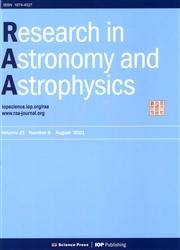Preparation for CSST: Star-galaxy Classification using a Rotationally Invariant Supervised Machine Learning Method
IF 2.8
4区 物理与天体物理
Q3 ASTRONOMY & ASTROPHYSICS
引用次数: 0
Abstract
Most existing star-galaxy classifiers depend on the reduced information from catalogs, necessitating careful data processing and feature extraction. In this study, we employ a supervised machine learning method (GoogLeNet) to automatically classify stars and galaxies in the COSMOS field. Unlike traditional machine learning methods, we introduce several preprocessing techniques, including noise reduction and the unwrapping of denoised images in polar coordinates, applied to our carefully selected samples of stars and galaxies. By dividing the selected samples into training and validation sets in an 8:2 ratio, we evaluate the performance of the GoogLeNet model in distinguishing between stars and galaxies. The results indicate that the GoogLeNet model is highly effective, achieving accuracies of 99.6% and 99.9% for stars and galaxies, respectively. Furthermore, by comparing the results with and without preprocessing, we find that preprocessing can significantly improve classification accuracy (by approximately 2.0% to 6.0%) when the images are rotated. In preparation for the future launch of the China Space Station Telescope (CSST), we also evaluate the performance of the GoogLeNet model on the CSST simulation data. These results demonstrate a high level of accuracy (approximately 99.8%), indicating that this model can be effectively utilized for future observations with the CSST.为 CSST 做准备:使用旋转不变监督机器学习方法进行恒星-星系分类
现有的恒星-星系分类器大多依赖于星表中的缩减信息,因此必须进行仔细的数据处理和特征提取。在这项研究中,我们采用了一种有监督的机器学习方法(GoogLeNet)来自动对 COSMOS 星场中的恒星和星系进行分类。与传统的机器学习方法不同,我们引入了多项预处理技术,包括降噪和极坐标去噪图像解包,并将其应用于我们精心挑选的恒星和星系样本。通过将所选样本按 8:2 的比例分为训练集和验证集,我们评估了 GoogLeNet 模型在区分恒星和星系方面的性能。结果表明,GoogLeNet 模型非常有效,对恒星和星系的识别准确率分别达到 99.6% 和 99.9%。此外,通过比较有预处理和无预处理的结果,我们发现当图像旋转时,预处理可以显著提高分类准确率(大约提高 2.0% 到 6.0%)。为了给中国空间站望远镜(CSST)的未来发射做准备,我们还评估了 GoogLeNet 模型在 CSST 模拟数据上的性能。这些结果表明该模型具有很高的准确性(约 99.8%),表明该模型可以有效地用于未来 CSST 的观测。
本文章由计算机程序翻译,如有差异,请以英文原文为准。
求助全文
约1分钟内获得全文
求助全文
来源期刊

Research in Astronomy and Astrophysics
地学天文-天文与天体物理
CiteScore
3.20
自引率
16.70%
发文量
2599
审稿时长
6.0 months
期刊介绍:
Research in Astronomy and Astrophysics (RAA) is an international journal publishing original research papers and reviews across all branches of astronomy and astrophysics, with a particular interest in the following topics:
-large-scale structure of universe formation and evolution of galaxies-
high-energy and cataclysmic processes in astrophysics-
formation and evolution of stars-
astrogeodynamics-
solar magnetic activity and heliogeospace environments-
dynamics of celestial bodies in the solar system and artificial bodies-
space observation and exploration-
new astronomical techniques and methods
 求助内容:
求助内容: 应助结果提醒方式:
应助结果提醒方式:


